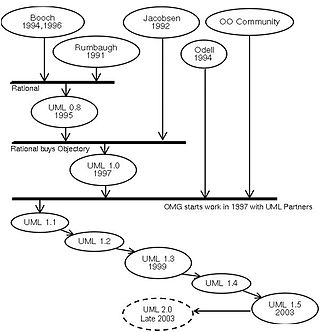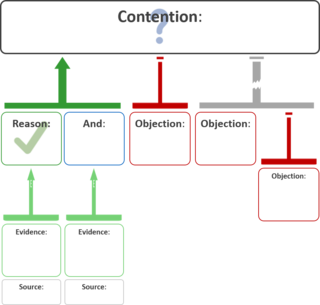Related Research Articles

An object-modeling language is a standardized set of symbols used to model a software system using an object-oriented framework. The symbols can be either informal or formal ranging from predefined graphical templates to formal object models defined by grammars and specifications.

The unified modeling language (UML) is a general-purpose visual modeling language that is intended to provide a standard way to visualize the design of a system.
A modeling language is any artificial language that can be used to express data, information or knowledge or systems in a structure that is defined by a consistent set of rules. The rules are used for interpretation of the meaning of components in the structure Programing language.

Computer-aided software engineering (CASE) was a domain of software tools used to design and implement applications. CASE tools were similar to and were partly inspired by Computer-Aided Design (CAD) tools used for designing hardware products. CASE tools were intended to help develop high-quality, defect-free, and maintainable software. CASE software was often associated with methods for the development of information systems together with automated tools that could be used in the software development process.

Data modeling in software engineering is the process of creating a data model for an information system by applying certain formal techniques. It may be applied as part of broader Model-driven engineering (MDD) concept.
GSN may refer to:

Business process modeling (BPM) in business process management and systems engineering is the activity of representing processes of an enterprise, so that the current business processes may be analyzed, improved, and automated. BPM is typically performed by business analysts, who provide expertise in the modeling discipline; by subject matter experts, who have specialized knowledge of the processes being modeled; or more commonly by a team comprising both. Alternatively, the process model can be derived directly from events' logs using process mining tools.

Stephen Edelston Toulmin was a British philosopher, author, and educator. Influenced by Ludwig Wittgenstein, Toulmin devoted his works to the analysis of moral reasoning. Throughout his writings, he sought to develop practical arguments which can be used effectively in evaluating the ethics behind moral issues. His works were later found useful in the field of rhetoric for analyzing rhetorical arguments. The Toulmin model of argumentation, a diagram containing six interrelated components used for analyzing arguments, and published in his 1958 book The Uses of Argument, was considered his most influential work, particularly in the field of rhetoric and communication, and in computer science.
The Shlaer–Mellor method, also known as object-oriented systems analysis (OOSA) or object-oriented analysis (OOA) is an object-oriented software development methodology introduced by Sally Shlaer and Stephen Mellor in 1988. The method makes the documented analysis so precise that it is possible to implement the analysis model directly by translation to the target architecture, rather than by elaborating model changes through a series of more platform-specific models. In the new millennium the Shlaer–Mellor method has migrated to the UML notation, becoming Executable UML.
Object-oriented analysis and design (OOAD) is a technical approach for analyzing and designing an application, system, or business by applying object-oriented programming, as well as using visual modeling throughout the software development process to guide stakeholder communication and product quality.

An argument map or argument diagram is a visual representation of the structure of an argument. An argument map typically includes all the key components of the argument, traditionally called the conclusion and the premises, also called contention and reasons. Argument maps can also show co-premises, objections, counterarguments, rebuttals, and lemmas. There are different styles of argument map but they are often functionally equivalent and represent an argument's individual claims and the relationships between them.
Eight Disciplines Methodology (8D) is a method or model developed at Ford Motor Company used to approach and to resolve problems, typically employed by quality engineers or other professionals. Focused on product and process improvement, its purpose is to identify, correct, and eliminate recurring problems. It establishes a permanent corrective action based on statistical analysis of the problem and on the origin of the problem by determining the root causes. Although it originally comprised eight stages, or 'disciplines', it was later augmented by an initial planning stage. 8D follows the logic of the PDCA cycle. The disciplines are:

The issue-based information system (IBIS) is an argumentation-based approach to clarifying wicked problems—complex, ill-defined problems that involve multiple stakeholders. Diagrammatic visualization using IBIS notation is often called issue mapping.

In systems engineering, software engineering, and computer science, a function model or functional model is a structured representation of the functions within the modeled system or subject area.
Process map is a global-system process model that is used to outline the processes that make up the business system and how they interact with each other. Process map shows the processes as objects, which means it is a static and non-algorithmic view of the processes. It should be differentiated from a detailed process model, which shows a dynamic and algorithmic view of the processes, usually known as a process flow diagram. There are different notation standards that can be used for modelling process maps, but the most notable ones are TOGAF Event Diagram, Eriksson-Penker notation, and ARIS Value Added Chain.
A goal model is an element of requirements engineering that may also be used more widely in business analysis. Related elements include stakeholder analysis, context analysis, and scenarios, among other business and technical areas.
A metaCASE tool is a type of application software that provides the possibility to create one or more modeling methods, languages or notations for use within the process of software development. Often the result is a modeling tool for that language. MetaCASE tools are thus a kind of language workbench, generally considered as being focused on graphical modeling languages.

Systems modeling or system modeling is the interdisciplinary study of the use of models to conceptualize and construct systems in business and IT development.
The Safety-Critical Systems Club (SCSC) is a professional association in the United Kingdom. It aims to share knowledge about safety-critical systems, including current and emerging practices in safety engineering, software engineering, and product and process safety standards.
One definition of a Safety Case is that it is a structured argument, supported by evidence, intended to justify that a system is acceptably safe for a specific application in a specific operating environment. Safety cases are often required as part of a regulatory process, a certificate of safety being granted only when the regulator is satisfied by the argument presented in a safety case. Industries regulated in this way include transportation and medical devices. As such there are strong parallels with the formal evaluation of risk used to prepare a Risk Assessment, although the result will be case specific. A vehicle safety case may show it to be acceptably safe to be driven on a road, but conclude that it may be unsuited to driving on rough ground, or with an off-center load for example, if there would then be a greater risk of danger e.g. a loss of control or an injury to the occupant. The information used to compile the safety case may then formally guarantee further specifications, such as maximum safe speeds, permitted safe loads, or any other operational parameter. A safety case should be revisited when an existing product is to be re-purposed in a new way, if this extends beyond the scope of the original assessment.
References
- 1 2 3 The Assurance Case Working Group (May 2021). Goal Structuring Notation Community Standard Version 3. ISBN 979-8451294949.
- 1 2 Kelly, Timothy Patrick (September 1998). Arguing Safety – A Systematic Approach to Managing Safety Cases (PDF) (PhD thesis). University of York.
- ↑ Ge, Xiaocheng; Rijo, Rui; Paige, Richard F.; Kelly, Tim P.; McDermid, John A. (2012). "Introducing Goal Structuring Notation to Explain Decisions in Clinical Practice". Procedia Technology. 5: 686–695. doi: 10.1016/j.protcy.2012.09.076 . ISSN 2212-0173.
- 1 2 Haddon-Cave QC, Charles (28 October 2009), The Nimrod Review, London: The Stationery Office
- 1 2 Cabot, Jordi (12 February 2014). "Goal Structuring Notation – a short introduction". Modeling Languages. Retrieved 21 June 2018.
- ↑ Spriggs, John (2012). GSN - The Goal Structuring Notation. Springer London. doi:10.1007/978-1-4471-2312-5. ISBN 978-1-4471-2311-8.
- ↑ Hawkins, R.D.; Kelly, T.P. (July 2010). "A Systematic Approach for Developing Software Safety Arguments". Journal of System Safety. 46 (4): 25–33. ISSN 0743-8826.
- ↑ The Assurance Case Working Group (Jan 2018). Goal Structuring Notation Community Standard Version 2.
- ↑ Habli, Ibrahim; Kelly, Tim (August 2007). Safety Case Depictions vs. Safety Cases – Would the Real Safety Case Please Stand Up? (PDF). 23rd International System Safety Conference.